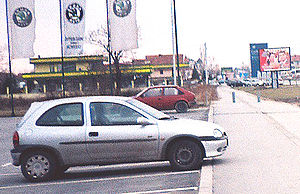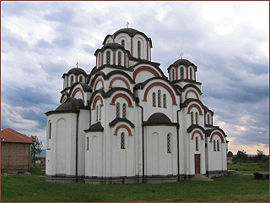
Veternik
Encyclopedia



Novi Sad
Novi Sad is the capital of the northern Serbian province of Vojvodina, and the administrative centre of the South Bačka District. The city is located in the southern part of Pannonian Plain on the Danube river....
, Serbia
Serbia
Serbia , officially the Republic of Serbia , is a landlocked country located at the crossroads of Central and Southeast Europe, covering the southern part of the Carpathian basin and the central part of the Balkans...
. It is located between Novi Sad
Novi Sad
Novi Sad is the capital of the northern Serbian province of Vojvodina, and the administrative centre of the South Bačka District. The city is located in the southern part of Pannonian Plain on the Danube river....
and Futog
Futog
Futog is a town in Serbia, in the Autonomous Province of Vojvodina. It is part of the metropolitan area of Novi Sad.-Name:The name Futog derives from Old Church Slavonic term for “on the mouth” - vo utok ....
. Its population numbers 16,895 (2011 census) and most of its inhabitants are ethnic Serbs
Serbs
The Serbs are a South Slavic ethnic group of the Balkans and southern Central Europe. Serbs are located mainly in Serbia, Montenegro and Bosnia and Herzegovina, and form a sizable minority in Croatia, the Republic of Macedonia and Slovenia. Likewise, Serbs are an officially recognized minority in...
. Over the years, especially in the 1990s, it grew with size and inhabitants thus merging with Futog
Futog
Futog is a town in Serbia, in the Autonomous Province of Vojvodina. It is part of the metropolitan area of Novi Sad.-Name:The name Futog derives from Old Church Slavonic term for “on the mouth” - vo utok ....
to the west and Novi Sad
Novi Sad
Novi Sad is the capital of the northern Serbian province of Vojvodina, and the administrative centre of the South Bačka District. The city is located in the southern part of Pannonian Plain on the Danube river....
to the east.
Name
The settlement was named in honour of the assault of the Serbian army in the Veternik mountain area during the breach of the Solun frontMacedonian front (World War I)
The Macedonian Front resulted from an attempt by the Allied Powers to aid Serbia, in the autumn of 1915, against the combined attack of Germany, Austria-Hungary and Bulgaria. The expedition came too late and in insufficient force to prevent the fall of Serbia, and was complicated by the internal...
in World War I
World War I
World War I , which was predominantly called the World War or the Great War from its occurrence until 1939, and the First World War or World War I thereafter, was a major war centred in Europe that began on 28 July 1914 and lasted until 11 November 1918...
. It was first called Novi Veternik ("New Veternik"), but was later changed into Veternik. The name Veternik itself means "windy" in Serbian. http://www.srpska-mreza.com/library/facts/November-1918.html
In Serbian
Serbian language
Serbian is a form of Serbo-Croatian, a South Slavic language, spoken by Serbs in Serbia, Bosnia and Herzegovina, Montenegro, Croatia and neighbouring countries....
Cyrillic, the settlement is known as Ветерник, in Serbian Latin and Croatian
Croatian language
Croatian is the collective name for the standard language and dialects spoken by Croats, principally in Croatia, Bosnia and Herzegovina, the Serbian province of Vojvodina and other neighbouring countries...
as Veternik, and in Hungarian
Hungarian language
Hungarian is a Uralic language, part of the Ugric group. With some 14 million speakers, it is one of the most widely spoken non-Indo-European languages in Europe....
as Hadikliget.
History
The first settlement at this location was mentioned in 1848 and its name was Neu Ilof. It was a settlement for workers that worked in the nearby estate whose last owner was count Kotek.The modern settlement was founded in 1918 as a settlement for Serb veterans from World War I
World War I
World War I , which was predominantly called the World War or the Great War from its occurrence until 1939, and the First World War or World War I thereafter, was a major war centred in Europe that began on 28 July 1914 and lasted until 11 November 1918...
. During World War II
World War II
World War II, or the Second World War , was a global conflict lasting from 1939 to 1945, involving most of the world's nations—including all of the great powers—eventually forming two opposing military alliances: the Allies and the Axis...
, the Hungarian occupational authorities relegated the population of the village across the Danube
Danube
The Danube is a river in the Central Europe and the Europe's second longest river after the Volga. It is classified as an international waterway....
, and settled Hungarians from Bukovina into their houses. After the war, the population returned and settlement largely developed in the next period: from only 789 inhabitants that were recorded by the 1948 census, the population of Veternik rose to 18,626 in 2002.
Demographics
The population of Veternik grow almost 100% in a decade, from 10,271 in 1991 censusCensus
A census is the procedure of systematically acquiring and recording information about the members of a given population. It is a regularly occurring and official count of a particular population. The term is used mostly in connection with national population and housing censuses; other common...
up to 18,626, according to the 2002 census. This is because of the civil war
Civil war
A civil war is a war between organized groups within the same nation state or republic, or, less commonly, between two countries created from a formerly-united nation state....
s in Croatia
Croatia
Croatia , officially the Republic of Croatia , is a unitary democratic parliamentary republic in Europe at the crossroads of the Mitteleuropa, the Balkans, and the Mediterranean. Its capital and largest city is Zagreb. The country is divided into 20 counties and the city of Zagreb. Croatia covers ...
and Bosnia and Herzegovina
Bosnia and Herzegovina
Bosnia and Herzegovina , sometimes called Bosnia-Herzegovina or simply Bosnia, is a country in Southern Europe, on the Balkan Peninsula. Bordered by Croatia to the north, west and south, Serbia to the east, and Montenegro to the southeast, Bosnia and Herzegovina is almost landlocked, except for the...
and post-war
Post-war
A post-war period or postwar period is the interval immediately following the ending of a war and enduring as long as war does not resume. A post-war period can become an interwar period or interbellum when a war between the same parties resumes at a later date...
immigration
Immigration
Immigration is the act of foreigners passing or coming into a country for the purpose of permanent residence...
from these two countries. According to the 2011 census Veternik had a population of 16,895 inhabitants, 1,731 less than 2002 census. Decreasing population is part of global decreasing population in Serbia.
Historical population:
- 1961: 1,908
- 1971: 5,730
- 1981: 9,556
- 1991: 10,271
- 2002: 18,626
- 2011: 16,895
Status
Officially, Veternik holds suburban settlement status, as it is part of the agglomeration of Novi Sad. Today, Veternik has merged with Novi Sad completely.Features


